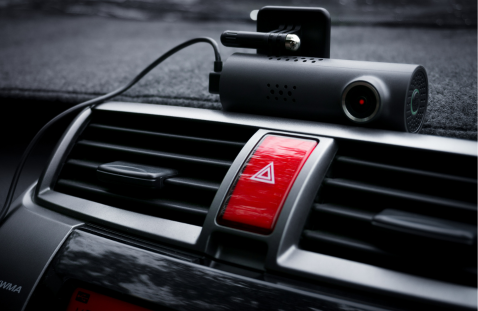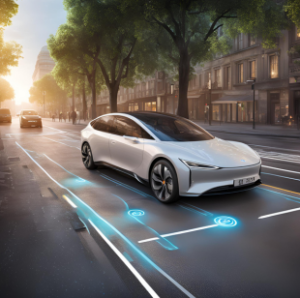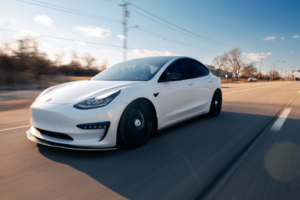Introduction
In today’s world, modern technology has woven itself into the fabric of our daily lives, transforming the way we interact with the world around us. From smart home devices to wearable gadgets, technology is continually enhancing comfort, convenience, and efficiency. One area where this transformation is especially noticeable is in the automotive industry, where innovations in car accessories are redefining how we experience driving.
As vehicles evolve from simple modes of transportation to sophisticated, tech-driven environments, the demand for hi-tech accessories has surged. No longer are cars just about getting from point A to point B—today, they are personalized spaces that cater to comfort, convenience, and connectivity. The growing trend of integrating smart technology into cars is reshaping the driving experience in ways we could have only imagined a few years ago.
These advancements are having a profound impact on car comfort, taking it to new heights. From seats that adjust to your every need to climate control systems that make the cabin feel like a personalized oasis, the modern car is quickly becoming a sanctuary for drivers and passengers alike. The fusion of cutting-edge technology and automotive design is making long drives more relaxing, efficient, and enjoyable than ever before.
The Rise of Hi-Tech Car Accessories
Car accessories have come a long way from their humble beginnings. In the early days of automobiles, accessories were simple add-ons designed to serve basic functions—think seat covers, floor mats, and basic radios. As technology progressed, so did the capabilities of these accessories. Today, car accessories are no longer just about adding convenience or style; they have become integral to enhancing the overall driving experience, offering a level of personalization and comfort that was once unimaginable.
The evolution of automotive technology has been a major driver in this transformation. With the advent of smart systems, artificial intelligence (AI), and the Internet of Things (IoT), cars are now more connected than ever before. These technologies enable a wide range of sophisticated features, from voice-activated controls to real-time data sharing between your car and the cloud. Through seamless integration of these advanced systems, manufacturers are able to offer a suite of high-tech accessories that enhance both the functionality and comfort of vehicles.
The demand for comfort-driven features has skyrocketed as consumers seek cars that cater to their needs in a more personalized way. Today’s drivers want more than just a vehicle that gets them from one place to another—they want a car that anticipates their needs, adjusts to their preferences, and offers a driving experience that feels tailored specifically to them. From advanced seating options to climate control and entertainment systems, the automotive industry is responding to this demand by introducing innovations that redefine what it means to be comfortable on the road.
Generate the text for the blog section
Smart Seats: Revolutionizing Comfort and Posture
When it comes to car comfort, seats are arguably the most important element—and modern advancements in seat technology are taking comfort to a whole new level. Gone are the days of simply adjusting seat positions manually to find a comfortable driving posture. Today’s smart seats are packed with features designed to enhance both comfort and health, ensuring that drivers and passengers can enjoy a premium experience on every journey.
One of the most sought-after features in modern car seats is the ability to heat or cool the seat, offering immediate relief in any climate. Heated seats are a welcome comfort on cold mornings, while ventilated seats keep you cool and dry during hot weather, providing a level of climate control that extends beyond the car’s cabin. But that’s just the beginning. Some high-end vehicles are now equipped with seats that offer full massage functions, providing a relaxing, therapeutic experience during long drives. These massage functions can target specific areas of the back, neck, and legs, helping to reduce fatigue and improve overall well-being during travel.
Beyond comfort, modern car seats also focus on improving posture. Features like memory foam and adjustable lumbar support are designed to align the spine, prevent discomfort, and support healthy posture. Memory foam adapts to the body’s contours, offering personalized comfort by distributing weight evenly across the seat. Adjustable lumbar support, which can be fine-tuned to match the unique shape of each driver or passenger’s back, helps maintain a neutral spine position and reduces the strain caused by long hours on the road.
For an even more tailored experience, many modern vehicles integrate seat settings with personal profiles. These profiles can store an individual’s seat preferences—such as seat position, lumbar support intensity, massage settings, and temperature control—so that the car can automatically adjust each time a specific driver enters the vehicle. This level of customization allows for a consistent and personalized experience, ensuring that both short commutes and long road trips are as comfortable as possible.
With these smart seat innovations, modern cars are transforming the way we think about comfort and posture on the road, making every journey a more pleasant, enjoyable experience.
Advanced Climate Control Systems
When it comes to comfort on the road, the cabin’s climate plays a crucial role. Modern vehicles are equipped with advanced climate control systems that go beyond traditional air conditioning and heating, offering a level of personalization and convenience that transforms the in-car environment.
One of the standout features in today’s cars is automatic climate control, which adjusts the temperature based on your preferences without the need for constant manual input. This system maintains a consistent temperature throughout the cabin, ensuring that you’re never too hot or too cold, regardless of external weather conditions. In many vehicles, automatic climate control is paired with air purifiers, which help remove dust, allergens, and pollutants from the air, improving air quality inside the car. These air purification systems create a cleaner, more pleasant environment, particularly for individuals with respiratory sensitivities or allergies.
Another innovative feature gaining traction in the automotive industry is the integration of smart thermostats. These thermostats not only regulate the temperature but can also learn your preferences over time. For example, they might adjust the cabin temperature based on the time of day or automatically respond to the external temperature. With these smart systems, your car can maintain an ideal climate without you having to think about it—whether you’re driving on a hot summer day or a chilly winter morning.
Beyond the cabin’s overall temperature, modern vehicles offer individual comfort features like seat heaters and cooling systems. Seat heaters are perfect for cold weather, providing quick warmth to the driver and passengers, while cooling seats offer a refreshing breeze on hot days, helping to prevent discomfort during long drives. These personalized features ensure that each occupant can maintain a comfortable temperature according to their own preferences, regardless of the season.
With the integration of these advanced climate control systems, vehicles are evolving into mobile, climate-controlled sanctuaries. Whether it’s ensuring a fresh, clean atmosphere or maintaining the perfect temperature, these technologies are revolutionizing how we experience comfort inside our cars.
Ambient Lighting and Mood Settings
In addition to functional features, modern cars are increasingly incorporating design elements that focus on enhancing the overall driving experience. One such feature that has gained popularity is ambient lighting, which not only adds to the aesthetic appeal of the vehicle but also plays a significant role in boosting comfort and relaxation during travel.
Ambient lighting systems are designed to create a soft, welcoming atmosphere inside the car, often using subtle LED lights placed along the dashboard, door panels, and footwells. These lights help to reduce glare from the car’s interior and provide a soothing ambiance, especially during nighttime driving. The ability to adjust the intensity and color of the lights adds a personalized touch, allowing drivers and passengers to create a cabin environment that feels more relaxing or energizing, depending on their mood or the time of day.
Smart lighting systems take this concept even further by adjusting the lighting based on external conditions and personal preferences. For example, some systems can automatically brighten or dim the lights based on the ambient light outside the vehicle, ensuring that the interior always feels comfortable. Others allow you to set specific moods for different situations—whether you’re looking for a calming, dim atmosphere during a long drive or vibrant, colorful lighting for a lively night out. These smart systems can even sync with the vehicle’s infotainment system, adjusting to the rhythm of the music or creating a dynamic light show to enhance the overall experience.
The colors and brightness of ambient lighting have a powerful influence on mood and relaxation. Studies have shown that certain colors can have a calming effect, while others can energize or stimulate. For instance, cool blue and green tones are known to reduce stress and promote relaxation, making them ideal for long journeys. On the other hand, warmer colors like red or amber can create a cozy, intimate setting, perfect for short commutes or evening drives. Additionally, adjusting the brightness of the lights can help reduce eye strain and create a more comfortable driving environment, particularly during low-light conditions.
By combining technology and design, ambient lighting and mood settings are revolutionizing how we experience comfort in the car. These features not only enhance the vehicle’s interior design but also contribute to a more personalized, relaxing, and enjoyable driving experience, especially on long trips or night-time commutes.
Noise-Cancelling Technology and Acoustic Comfort
One of the most significant improvements in modern vehicles is the focus on creating a quieter, more peaceful driving environment. In today’s fast-paced world, long commutes and road trips can often be accompanied by unwanted noise from traffic, the engine, and even road imperfections. Noise-cancelling technology has emerged as a solution to reduce this distraction, making every journey more comfortable and relaxing for both drivers and passengers.
At the heart of this innovation are noise-cancelling systems, which use advanced technology to detect and counteract unwanted sounds. These systems employ microphones within the vehicle to pick up external noises, such as engine hums or road noise, and generate sound waves that are the exact opposite (anti-phase). This process effectively cancels out the noise, creating a quieter cabin. Noise-cancelling technology is particularly beneficial during long drives, helping to reduce fatigue caused by constant, low-frequency sounds.
In addition to active noise cancellation, many vehicles are now equipped with acoustic glass. This specialized glass helps to block out external noise by incorporating a layer of sound-dampening material between the panes of glass. Acoustic glass is particularly effective at reducing high-frequency noise, such as wind and traffic sounds, creating a more serene environment inside the vehicle. When paired with soundproofing materials within the vehicle’s structure, this further enhances the overall acoustic comfort, preventing noise from seeping in through the doors, windows, or floor.
The integration of active noise control and soundproofing technologies works hand-in-hand to ensure that drivers and passengers are surrounded by a peaceful environment. For example, some vehicles use vibration-dampening materials in the chassis and interior panels to reduce the noise generated by road contact. Additionally, soundproofing materials in the cabin help to absorb and dissipate sound, further improving the acoustic comfort.
The impact of reduced noise levels on driver and passenger comfort is undeniable. A quieter cabin not only makes for a more enjoyable and relaxed ride, but it can also improve safety by allowing drivers to hear essential sounds like sirens, honking, or other vehicles approaching. Moreover, a peaceful environment reduces mental fatigue, enabling drivers to remain more focused and alert, especially on long journeys. For passengers, the reduction in noise can make the ride more comfortable, particularly on longer trips, where a quiet, calm atmosphere contributes to better relaxation and sleep.
Noise-cancelling technology and acoustic improvements are transforming the way we experience driving, ensuring that comfort and peace of mind are no longer just limited to the destination but are a key part of the journey itself.
Wireless Charging and Connectivity for Convenience
In our increasingly connected world, staying powered up and in touch is essential, even when we’re on the road. Modern cars are addressing this need by integrating advanced wireless charging and connectivity features that make it easier than ever to keep devices powered without the hassle of cords or tangled cables. These innovations ensure that both drivers and passengers can stay connected and charged while maintaining a seamless, comfortable driving experience.
One of the most notable advancements in this area is the inclusion of wireless charging pads. These pads allow drivers and passengers to charge their smartphones, tablets, and other devices without needing to plug in any cables. Simply placing your device on the charging pad triggers the power transfer, providing a convenient and clutter-free solution for staying powered up on the go. In addition to wireless charging pads, many cars are also equipped with multiple USB ports, which offer additional options for charging devices or connecting them to the car’s infotainment system.
Beyond charging, hi-tech car accessories have significantly improved connectivity, allowing drivers and passengers to stay linked to their digital lives without compromising comfort. Modern infotainment systems feature seamless integration with smartphones, offering features like Apple CarPlay and Android Auto, which allow you to use your phone’s apps, make calls, or access navigation tools directly through the car’s touchscreen interface. This integration means you can easily stream music, send messages, and use GPS without fumbling for your phone, keeping your focus on the road while still enjoying all the benefits of your connected devices.
The role of 5G, Bluetooth, and wireless systems is also key in maintaining a modern, connected car environment. With 5G technology now being integrated into some vehicles, drivers and passengers can enjoy faster data speeds, allowing for smoother streaming, quicker downloads, and improved access to real-time information like traffic updates and navigation routes. Bluetooth connectivity further enhances this experience by allowing for hands-free communication, whether for making calls or streaming music. Many vehicles now support wireless audio systems, meaning you can connect your phone or other devices without the need for wires, offering a cleaner, more convenient cabin experience.
These connectivity features ensure that, whether you’re on a short commute or a long road trip, you remain connected to the things that matter most, all while keeping your car’s cabin free of clutter and distractions. With the seamless integration of wireless charging, smart systems, and advanced connectivity features, modern vehicles are transforming into mobile hubs of convenience, where comfort and connectivity go hand in hand.
In-Car Entertainment Systems
Long drives, whether for commuting or road trips, can often feel monotonous without some form of entertainment. Fortunately, modern cars are equipped with advanced in-car entertainment systems designed to keep passengers engaged and entertained throughout the journey. These systems have transformed the car from a simple mode of transportation into a mobile entertainment hub, offering a wide range of features to make every trip more enjoyable.
One of the cornerstones of these entertainment systems is the integration of infotainment technology, which brings a host of features into the car’s dashboard. With touchscreen displays serving as the central hub, passengers can easily navigate through a variety of entertainment options—whether it’s music, podcasts, audiobooks, or video streaming. These intuitive touchscreens are often paired with voice recognition technology, allowing drivers and passengers to control various functions without taking their hands off the wheel or eyes off the road. Simple voice commands can manage music, navigation, phone calls, and even climate control, offering a safer and more convenient way to interact with the system.
The ability to stream content is another major enhancement in modern in-car entertainment. With built-in access to popular streaming platforms like Spotify, Apple Music, Netflix, and YouTube, passengers can enjoy their favorite songs, movies, or TV shows on the go. Streaming ensures that there is always something fresh and exciting to watch or listen to, making the time pass more quickly during long journeys. Many vehicles are also equipped with Wi-Fi hotspots, allowing passengers to connect their devices to the internet, making it easy to stream content, browse the web, or stay connected to social media throughout the trip.
For families and those with young passengers, in-car entertainment systems also often include options for gaming and movies, further enhancing the road trip experience. Rear-seat entertainment systems can feature individual screens where children can watch their favorite movies or play video games, keeping them entertained for hours. Some cars even offer built-in gaming consoles or connectivity to gaming platforms, ensuring that passengers can enjoy their favorite games, whether it’s a quick mobile game or a full-fledged console experience.
These entertainment systems are not just about keeping passengers entertained—they also enhance convenience and comfort by offering features that make long trips more enjoyable. Whether it’s easy access to entertainment, the ability to stream movies, or keeping kids busy with games, modern in-car entertainment systems are making travel more fun and engaging than ever before.
Safety Features and Comfort Combined
In addition to enhancing comfort, modern vehicles are also equipped with advanced safety features that work seamlessly alongside comfort technologies to improve the overall driving experience. Advanced Driver Assistance Systems (ADAS) have become a game-changer in this regard, offering a combination of safety and convenience that helps reduce driver stress while ensuring a safer, more relaxed journey.
One of the standout features of ADAS is adaptive cruise control, which automatically adjusts the car’s speed to maintain a safe distance from the vehicle ahead. Unlike traditional cruise control, which requires the driver to manually adjust speed, adaptive cruise control takes the hassle out of highway driving by automatically slowing down and speeding up as traffic conditions change. This not only makes long drives more comfortable but also reduces the mental load on the driver, allowing them to focus more on the road ahead.
Lane-keeping assist is another feature that adds to both safety and comfort. This system uses sensors to detect lane markings and gently steers the vehicle to help prevent unintentional lane departures. For drivers who find themselves fatigued or distracted on long trips, lane-keeping assist provides an added layer of reassurance, ensuring that the vehicle stays centered in its lane. This feature reduces the likelihood of accidents caused by drifting and contributes to a more relaxed, stress-free driving experience.
Parking sensors and automatic parking assistance are also important components of ADAS that enhance convenience. Parking can be a stressful and challenging task, especially in tight spaces. With sensors that detect obstacles and provide visual or audible warnings, drivers are able to park with greater precision and confidence. In some vehicles, automatic parking systems even take over the steering, guiding the car into a parking space with minimal input from the driver. This makes parking easier and less stressful, creating a more comfortable experience in urban environments.
These safety technologies work together to reduce driver stress by taking over certain tasks and providing real-time assistance. For instance, adaptive cruise control and lane-keeping assist reduce the effort required for maintaining speed and staying in the lane, while parking sensors help prevent accidents during low-speed maneuvers. As a result, these features allow drivers to feel more at ease, whether they’re on a long highway journey or navigating a crowded city street.
By combining cutting-edge safety technologies with comfort-enhancing features, today’s cars are not only making driving safer but also more enjoyable. ADAS systems reduce the mental and physical strain on the driver, making every journey feel more effortless and secure, while contributing to a greater sense of overall well-being on the road.
Conclusion
In summary, hi-tech accessories are revolutionizing the concept of car comfort, transforming vehicles into more personalized, efficient, and enjoyable spaces. From smart seats that offer personalized adjustments for ultimate comfort, to advanced climate control systems ensuring an ideal cabin environment, the integration of cutting-edge technology is enhancing every aspect of the driving experience. Features like ambient lighting create relaxing atmospheres, while noise-cancelling technology ensures a peaceful ride. Wireless charging and connectivity keep us seamlessly connected, and in-car entertainment systems make long journeys more enjoyable. Finally, safety features like adaptive cruise control and lane-keeping assist not only protect us but also reduce stress, making driving more comfortable and effortless.
As technology continues to evolve, the future of automotive comfort looks even more promising. With ongoing advancements in AI, IoT, and connectivity, cars will only become more intuitive, adapting to individual preferences and enhancing the overall driving experience. The integration of smart systems, autonomous driving features, and further innovations in comfort technologies will continue to reshape how we perceive and enjoy our time on the road.
In the end, these technologies don’t just enhance convenience—they transform the entire driving experience. By making driving safer, more comfortable, and more enjoyable, hi-tech accessories are setting a new standard in automotive design. As we look ahead, the evolution of car comfort will undoubtedly redefine what it means to hit the road, ensuring that every journey is as enjoyable and effortless as possible.
Call to Action
Are you ready to elevate your driving experience? Explore the latest hi-tech car accessories and discover how these innovations can transform your vehicle into a more comfortable, connected, and enjoyable space. Whether you’re looking for smart seats, advanced climate control, or cutting-edge entertainment systems, there’s a tech upgrade that’s perfect for you.
We’d love to hear from you! How has technology improved your car comfort? Share your thoughts and experiences in the comments below—let’s start a conversation about how tech is reshaping the way we drive.
For those interested in making a tech upgrade, check out our product reviews and links to affiliate products that feature some of the best car accessories on the market. Start enhancing your comfort on the road today!




